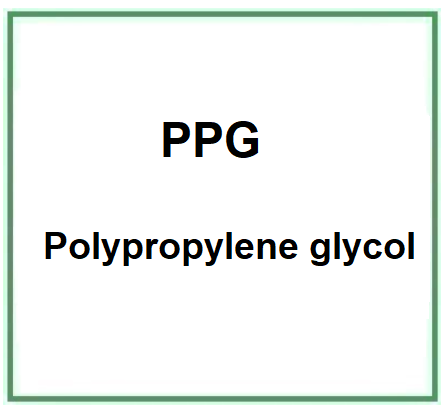PPG (polypropylene glycol) is a chemical compound, an aliphatic alcohol, a polymer molecule composed of repeating units of propylene glycol derived from the polymerization of propylene oxide. PPG has hygroscopic properties and can be mixed with various other solvents, both polar and nonpolar.
The name describes the structure of the molecule:
- "PPG" stands for "Polypropylene Glycol", indicating a series of propylene glycol polymers.
Description of raw materials used in production and their functions.
- Propylene oxide (PO). This is the basic monomer that, once polymerized, produces polypropylene glycol.
Step-by-step summary of industrial chemical synthesis process.
- Polymerization. The propylene oxide is subjected to open-chain polymerization in the presence of a catalyst and under specific temperature and pressure conditions to produce polypropylene glycol.
- Molecular weight control. The chain length of the PPG and hence its molecular weight can be controlled by varying the amount of propylene oxide and the reaction conditions.
- Purification. After polymerization, the product might contain traces of monomers, catalysts, or other impurities. These are removed through various purification processes.
PPG (polypropylene glycol) is a viscous, colorless, and odorless liquid

What it is for and where
Cosmetics
Skin conditioning agent. It is the mainstay of topical skin treatment as it has the function of restoring, increasing or improving skin tolerance to external factors, including melanocyte tolerance. The most important function of the conditioning agent is to prevent skin dehydration, but the subject is rather complex and involves emollients and humectants that can be added in the formulation.
Viscosity decreasing Agent. Since viscosity is important for increasing the chemical and physical stability of the product, Viscosity Reducing Agent is an important dosage factor in gels, suspensions, emulsions, solutions.
Solvent. It is the substance for dissolving or dispersing surfactants, oils, dyes, flavourings, bactericidal preservatives in solution.In fact, it dissolves other components present in a cosmetic formulation. Solvents are generally liquid (aqueous and non-aqueous).
Fragrance. It plays a very important role in the formulation of cosmetic products as it provides the possibility of enhancing, masking or adding fragrance to the final product, increasing its marketability. It is able to create a perceptible pleasant odour, masking a bad smell. The consumer always expects to find a pleasant or distinctive scent in a cosmetic product.
Safety
PPG (Polypropylene glycol) in small quantities is a safe, biocompatible, biodegradable polymer that produces pyruvic acid, a metabolite that our body uses to produce metabolic energy.
Commercial Applications
Cosmetics and Personal Care. PPG is used as a humectant, solvent, and carrier in various products like creams, lotions, deodorants, and make-up.
Industrial Production. Used as a hydraulic fluid, lubricant, and in heat transfer fluids.
Food Industry. It can be used as a solvent for flavors and food coloring.
Plastic and Polymer Production. It might be utilized as an intermediate in polyurethane production.
Medical Applications
Pharmaceuticals. PPG can be used as a solvent or vehicle in some pharmaceutical preparations.
References_____________________________________________________________________
(1) Fiume MM, Bergfeld WF, Belsito DV, Hill RA, Klaassen CD, Liebler D, Marks JG Jr, Shank RC, Slaga TJ, Snyder PW, Andersen FA. Safety assessment of propylene glycol, tripropylene glycol, and PPGs as used in cosmetics. Int J Toxicol. 2012 Sep-Oct;31(5 Suppl):245S-60S. doi: 10.1177/1091581812461381. PMID: 23064775.
Abstract. Propylene glycol is an aliphatic alcohol that functions as a skin conditioning agent, viscosity decreasing agent, solvent, and fragrance ingredient in cosmetics. Tripropylene glycol functions as a humectant, antioxidant, and emulsion stabilizer. Polypropylene glycols (PPGs), including PPG-3, PPG-7, PPG-9, PPG-12, PPG-13, PPG-15, PPG-16, PPG-17, PPG-20, PPG-26, PPG-30, PPG-33, PPG-34, PPG-51, PPG-52, and PPG-69, function primarily as skin conditioning agents, with some solvent use. The majority of the safety and toxicity information presented is for propylene glycol (PG). Propylene glycol is generally nontoxic and is noncarcinogenic. Clinical studies demonstrated an absence of dermal sensitization at use concentrations, although concerns about irritation remained. The CIR Expert Panel determined that the available information support the safety of tripropylene glycol as well as all the PPGs. The Expert Panel concluded that PG, tripropylene glycol, and PPGs ≥3 are safe as used in cosmetic formulations when formulated to be nonirritating.
Other studies
Hosoya Y, Taguchi T, Arita S, Tay FR. Clinical evaluation of polypropylene glycol-based caries detecting dyes for primary and permanent carious dentin. J Dent. 2008 Dec;36(12):1041-7. doi: 10.1016/j.jdent.2008.08.010.
Ohtsubo Y, Nagata Y, Numata M, Tsuchikane K, Hosoyama A, Yamazoe A, Tsuda M, Fujita N, Kawai F. Complete Genome Sequence of Polypropylene Glycol- and Polyethylene Glycol-Degrading Sphingopyxis macrogoltabida Strain EY-1. Genome Announc. 2015 Dec 3;3(6):e01399-15. doi: 10.1128/genomeA.01399-15.
Draing C, Traub S, Deininger S, Mang P, Möller HM, Manso M, Rossi F, Morath S, Hartung T, von Aulock S. Polypropylene glycol is a selective binding inhibitor for LTA and other structurally related TLR2 agonists. Eur J Immunol. 2008 Mar;38(3):797-808. doi: 10.1002/eji.200737466.
Hu X, Fukutani A, Liu X, Kimbara K, Kawai F. Isolation of bacteria able to grow on both polyethylene glycol (PEG) and polypropylene glycol (PPG) and their PEG/PPG dehydrogenases. Appl Microbiol Biotechnol. 2007 Jan;73(6):1407-13. doi: 10.1007/s00253-006-0616-y.
![]() Polypropylene glycol
Polypropylene glycol 



